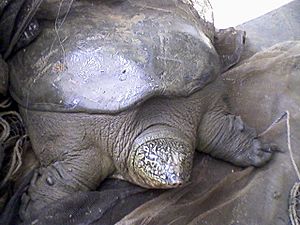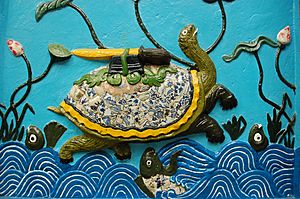Yangtze giant soft-shell turtle facts for kids
The Yangtze giant softshell turtle, also known as the Hoan Kiem turtle or Red River giant softshell turtle (Rafetus swinhoei), is a very rare turtle from Asia. It is one of the most endangered animals in the world. Sadly, only a few of these special turtles are known to be alive today.
Quick facts for kids Yangtze giant softshell turtle |
|
|---|---|
 |
|
| One of the two R. swinhoei of Dong Mo, Son Tay, Vietnam | |
| Conservation status | |
| Scientific classification | |
| Genus: |
Rafetus
|
| Species: |
swinhoei
|
| Synonyms | |
|
|
In 2019, the last known female Yangtze giant softshell turtle died in a zoo in Suzhou, China. However, good news came in October 2020 when another female was found in Vietnam! Scientists checked her DNA and then safely returned her to the lake.
Right now, there are four known turtles left. One male turtle lives at Suzhou Shangfangshan Forest Zoo. The female found in 2020 lives in Dong Mo Lake in Vietnam. There might be another turtle in Dong Mo Lake, and one more in Xuan Khanh Lake in Vietnam. Scientists are not sure if the Xuan Khanh lake turtle is male or female. Some experts, like scientist Tim McCormack, believe the lake turtles became stuck when people built dams on their rivers. Scientists are still searching for more of these turtles in other lakes and rivers.
Contents
What Does This Turtle Look Like?
This turtle is truly enormous! It has a unique, pointy nose that helps it breathe while most of its body stays hidden underwater. Scientists do not know much about how these turtles act in the wild because so few are left.
The Yangtze giant softshell turtle is the largest turtle that lives in fresh water (not sea water). It has a long, flat body. These turtles can weigh a lot, from 150 to 220 kilograms (330 to 485 pounds). That's heavier than two grown-up people!
Reproduction and Eggs
A female Yangtze giant softshell turtle can lay 30 or 40 eggs at a time. She can do this more than once each year.
Where Did These Turtles Live?
The Yangtze giant softshell turtle used to live in the Red River in China and in many parts of Vietnam. They lived in the flat, watery areas near the Yangtze River.
These turtles became endangered for several reasons. Humans built roads, buildings, and dams in the areas where the turtles liked to live. Pollution also harmed their homes. People also caught the turtles to eat them and their eggs. Some were even sold as pets. Illegal hunters also caught them to sell their body parts for use in traditional Chinese medicine.
The Turtle in Vietnamese Legends
In Vietnamese culture, the Yangtze giant softshell turtle is a very important symbol. It represents Kim Qui, the Great Turtle God. There is a famous story about the Dragon King giving a special sword called Heaven's Will to a Vietnamese hero, Emperor Lê Lợi. Emperor Lê Lợi used this sword to help Vietnam become free from Chinese rule. When it was time for the Emperor to return the sword to the Dragon King, he gave it to Kim Qui, the Great Turtle God, to deliver.
Efforts to Save the Turtles
In 2007, scientists made an exciting discovery. They found a female Yangtze giant softshell turtle in a zoo in Changsha, China. This turtle had been living there for over fifty years, long before these turtles became so rare. The zoo staff knew she was a large female turtle, but they did not realize she was one of the rarest animals on Earth! The zoo's deputy director was at a conference about tigers and decided to listen to a speech about turtles just for fun. He was amazed to hear them talking about the same kind of turtle that was in his zoo.
The people in Changsha knew they had a big turtle, but they did not know it was a Yangtze giant softshell turtle. A circus performer had sold her to the zoo in the 1950s. They fed her raw meat, which kept her healthy. However, this diet was not good for her eggs. She laid eggs every year, but they never hatched. This was because no male turtle had fertilized them. Also, she needed to eat foods with more calcium to make strong eggshells.
When everyone learned that the Changsha turtle was a female Yangtze giant softshell turtle, they did not move her to Suzhou right away. Both cities wanted the other turtle to come to them. Turtles are symbols of living a long time in China, so the people of Changsha did not want to give her away. Eventually, the two zoos agreed that the female should move to Changsha. They also agreed to share any baby turtles that might hatch. In 2008, the female turtle was moved from the Changsha Zoo to Suzhou Shangfangshan Forest Zoo.
Challenges in Reproduction
In the first year, the female turtle laid many eggs, and about half of them were fertilized. But none of them hatched. Some of the eggs had very thin shells. The zookeepers realized the turtle was not getting enough calcium from her food. So, they changed her diet to include more calcium. They also noticed that visitors were throwing food and trash into the turtle's lake, even though there were big signs telling them not to. This was also bad for the turtle's health.
Starting in 2015, the zookeepers tried a special method called artificial insemination. They collected the male turtle's male reproductive liquid and carefully placed it inside the female using medical tools. Again, the female turtle laid eggs, but none hatched. The scientists tried a different medical technique every year, hoping to find one that would work.
Sadly, in 2019, the female turtle died. She did not wake up from the medicine the zookeepers gave her to make her sleep during the medical process. The zookeepers quickly took and froze tissue from her female reproductive organs. They hope this tissue might help in future efforts to save these turtles.
Images for kids
See also
 In Spanish: Tortuga de Swinhoe para niños
In Spanish: Tortuga de Swinhoe para niños




